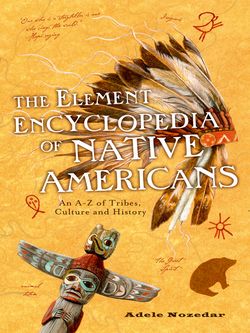Читать книгу The Element Encyclopedia of Native Americans: An A to Z of Tribes, Culture, and History - Adele Nozedar - Страница 29
ARAPAHO
ОглавлениеWhen the settlers first came upon them, the Arapaho were already expert horsemen and buffalo hunters. Their territory was originally what has become northern Minnesota, but the Arapaho relocated to the eastern Plains areas of Colorado and Wyoming at about the same time as the Cheyenne; because of this, the two people became associated and are also federally recognized as the Cheyenne and Arapaho tribes. The Arapaho were also aligned with the Sioux.
The Arapaho tongue is part of the Algonquian language group. In later years—toward the end of the 1870s—the Northern Arapaho would be further relocated to the Wind River Reservation in Wyoming, while the Southern Arapaho went to live with the Cheyenne in Oklahoma. Despite this close association, which often meant intermarriage, each people retained its own customs and language. One major cultural difference between the two, for example, is that the Arapaho buried their dead in the ground, whereas the Cheyenne made a raftlike construction on which to lay their deceased, leaving birds and animals to devour the remains. The Arapaho were tipi dwellers, part of the Woodland Culture tribes. It was this group that were the originators of the Sun Dance. They also had a government of consensus.
Like other Native Americans, the Arapaho and the horse took to one another as though they’d been designed to; this meant that the tribe could travel further and faster, and also had the capability of carrying goods and chattels more efficiently than before. Fishing and hunting—which included hunting buffalo—provided much of what the Arapaho needed to survive.
In 1851, the First Fort Laramie Treaty set the boundaries of the Arapaho land, from the Arkansas River in the south to the North Platte in the north, and from the Continental Divide in the west to western Kansas and Nebraska. When gold was discovered near Denver in the late 1850s, contact with the settlers increased rapidly, and in 1861 there was an attempt to shift some of the Arapaho to a chunk of land along the Arkansas River. The Arapaho did not agree to this, however, and the treaty remained unenforceable in law. However, the matter escalated when in 1864 a peaceable band of Arapaho, camping along Sand Creek in the southeastern part of Colorado, were brutally attacked by a Colonel Chivington, who had wanted to prove himself a war hero. These Arapaho had no warning whatsoever. The Sand Creek Massacre, as it came to be known, included the slaughter of women, children, and elderly people, and ignited angry conflict in the mid 1860s. Rather than giving him heroic status, the matter brought shame to Chivington. Eventually, treaties were agreed that saw the Southern Arapaho settling in west central Oklahoma.
The Northern Arapaho became embroiled in Red Cloud’s War between 1866 and 1867. Sparked by the white man encroaching on Native American buffalo-hunting territory in Montana after gold was discovered there, the Arapaho, Cheyenne, and Sioux were victorious. The conflict continued, however, climaxing in the Battle of Little Big Horn and the defeat of General Custer in 1877. Today, the Arapaho are among the peoples who operate casinos, one of which is located at the Wind River Reservation in Wyoming.
